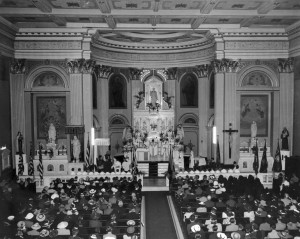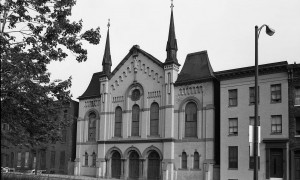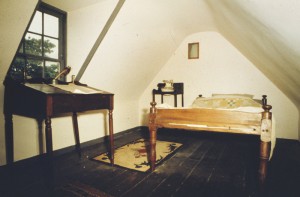Explore the stories of a 200-year-old graveyard for Baltimore’s Old Defenders, the “Mother Church of West Baltimore,” the Edgar Allan Poe House and more historic landmarks in Poppleton.
 Baltimore hired surveyor and map-maker Thomas H. Poppleton in the early 1800s to lay out a plan for the development of Baltimore’s streets in a grid across the city. In the southwest Baltimore neighborhood that took his name, countless immigrants, investors, workers, and entrepreneurs arrived over the last 200 years to build the many local landmarks featured in this short introduction to the area’s rich history.
Baltimore hired surveyor and map-maker Thomas H. Poppleton in the early 1800s to lay out a plan for the development of Baltimore’s streets in a grid across the city. In the southwest Baltimore neighborhood that took his name, countless immigrants, investors, workers, and entrepreneurs arrived over the last 200 years to build the many local landmarks featured in this short introduction to the area’s rich history.
Old St. Paul’s Cemetery
Opened in 1802 (just five years after Baltimore became a city), Old St. Paul’s Cemetery is the final resting place of men and women that include a signatory to the Declaration of Independence, a Supreme Court Justice, and a Governor of Maryland. Among the scores of storied veterans from the American Revolution, the War of 1812, and the Civil War buried on the grounds are John Eager Howard (1752-1857) who donated the land for Lexington Market and George Armistead (1780-1818) who commanded Fort McHenry during the Battle of Baltimore. Today, a high stone wall surrounds the cemetery and provides some protection from the busy traffic of Martin Luther King Boulevard, whose construction cut the grounds in half in the 1980s.
Poppleton Fire Station

The handsome Tudor Revival turrets of the Poppleton Fire Station (Engine House #38) stand out next to the modern glass facades of the University of Maryland BioPark on Baltimore Street. Designed by local architects Benjamin Buck Owens and Spencer E. Sisco, the station opened in 1910 equipped with the most modern fire-fighting tools available. After the tragedy of Great Baltimore Fire destroyed much of the city’s downtown in 1904, the Baltimore Fire Department grew quickly and built scores of new firehouses. A close look above the building’s arched entrance reveals a small tribute to the bravery of the Fire Department’s mission with a stone carving of firemen racing to extinguish a fire.
St. Peter the Apostle Church

St. Peter the Apostle Church served southwest Baltimore’s large Irish Catholic community for over 160 years. From its dedication in September 1844 through its final service in January 2008, the church earned a reputation as “The Mother Church of West Baltimore” for its role in the growth of the Catholic church. Built from 1843 to 1844, the handsome Greek Revival building was designed by prominent Baltimore architect Robert Cary Long, Jr. who modeled the church on the Temple of Hephaestus in Athens, Greece. The building is now owned by nearby Carter Memorial Church.
Lithuanian Hall
Known for much of the last century as Lietuvių Namai, Lithuanian Hall is familiar to more than just Baltimore’s Lithuanian immigrant community as in recent years local bands and promoters have turned “Lith Hall” into a popular venue again. The hall first opened in 1914 in three Barre Street rowhouses but a growing population of Lithuanian immigrants, including many who attended St. Alphonsus Church nearby on Saratoga Street, needed a larger hall for community gatherings. After raising funds from individuals, local businesses, and fraternal organizations, the handsome hall on Hollins Street, which is designed by architect Stanislaus Russell, opened to a full month of celebrations in February 1921.
Carter Memorial Church

The congregation of the Carter Memorial Church has its origins in 1926 when James Roosevelt Carter and his wife Catherine Carter arrived in Baltimore from Pennsylvania. James Carter spent years preaching on the city streets before opening his first church on Lombard Street in 1944. The congregation continued to grow and by 1955 under the name of the “Garden Of Prayer Church Of God In Christ” purchased the former home of the Beechfield Methodist Church that was originally built in 1833 as the Fayette Street Methodist Episcopal Church. The congregation has continued to grow and recently purchased St. Peter the Apostle.
Edgar Allan Poe House

Famous for his poem “The Raven” and spooky stories like “The Tell-Tale Heart,” Edgar Allan Poe grew up in Richmond but had deep family roots in Baltimore. Poe moved to the city in 1833 to live with his aunt Maria Clemm and cousin Virginia in their modest Amity Street rowhouse. Poe’s successful entry in the Baltimore Saturday Visiter writing competition helped to launch his literary career. After he left the city in 1835, Poe never lived in Baltimore again but died here in October 1849 and is buried at the Westminster Burial Ground. When the development of public housing threatened Poe’s Amity Street rowhouse with demolition in 1938, the Edgar Allan Poe Society saved the building and created the museum that we love today.
Perkins Square
“The square is triangular in shape, and is noted for the beauty of its flowers and careful gardening. Luxuriant beds of coleus and petunias in the most varied colors attract the eye of the visitor, the designs being anchors, stars, shields etc., of the most elaborate kind.”
John Thomas Scharf, 1881
As early as the 1840s, a small oasis of green known as Perkins’ Spring became a popular destination thanks to a natural spring where water bubbled up at a rate of 60 gallons a minute. In 1853, the city purchased a small triangle of land around the spring from the estate of Dr. Joseph Perkins and improved the spring with a brick enclosure and a cast iron Moorish-style canopy. The park and surrounding blocks have been transformed by the construction and then later demolition of the George P. Murphy Homes but the colorful canopy still stands.

